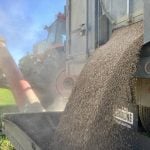Anew report compiled by Alberta Reduced Tillage LINKAGES (RTL), which ceased operations last month, highlights the benefits of reduced tillage. The report, co-authored by Dr. Mirza Baig of Consulting Options, Edmonton, and Peter Gamache, former Team Leader of RTL, summarizes all the economic, agronomic and environmental benefits of no till with special emphasis on Alberta. Between 1991 and 2006, no-till farming acreages in Alberta rose from 0.6 million to 9.0 million acres, an increase of 1,358 per cent.
Key findings include:
increased grain yield of 3.5 per cent in wheat, 6.2 per cent in barley, 7.95 per cent in flax, 4.6 per cent in peas and 13 per cent in lentils
Read Also

Hail research hopes to benefit potato growers
Alberta research scientist measures hail storm and heat dome affects on potato crops
a significant reduction in labour cost (up to 80 per cent), fuel consumption (up to 80 per cent), and machinery use
soil conservation with reduced tillage has reduced the risk of soil erosion to a small proportion of agricultural land
no till increases water infiltration into the soil, reduces sediment and pesticide losses that would otherwise enter the watershed, and may reduce phosphorus and nitrogen loss
land converted to no till sequesters atmospheric CO2 into the soil to reduce greenhouse gas and enhances the carbon sink of soils
studies have shown that no-till farming practices have a greater abundance and diversity of wildlife, including songbirds, ducks, small mammals and soil arthropods
no till enhances the physical, chemical and biological properties in the soil, resulting in greater agricultural sustain-ability
An executive summary and complete report can be found at www.reducedtillage.ca.














